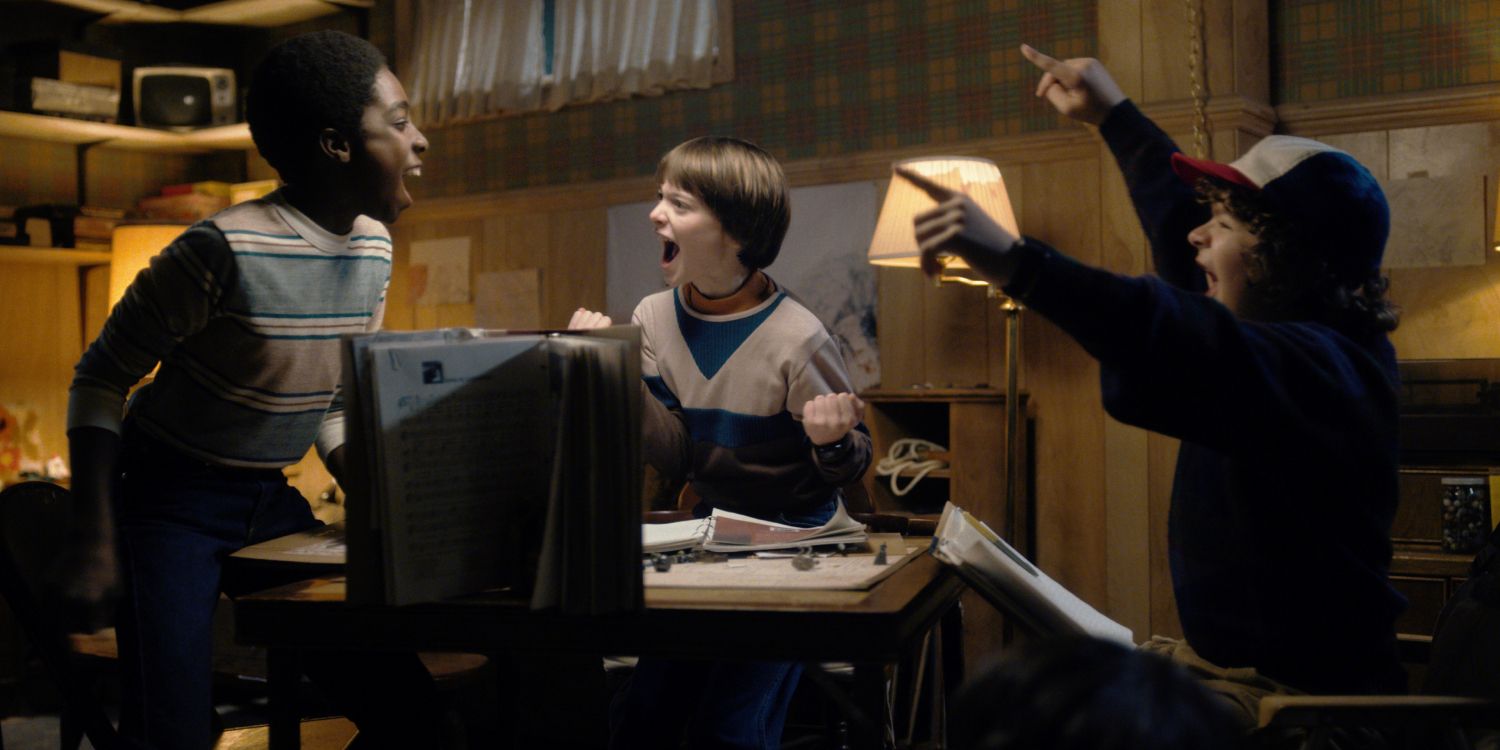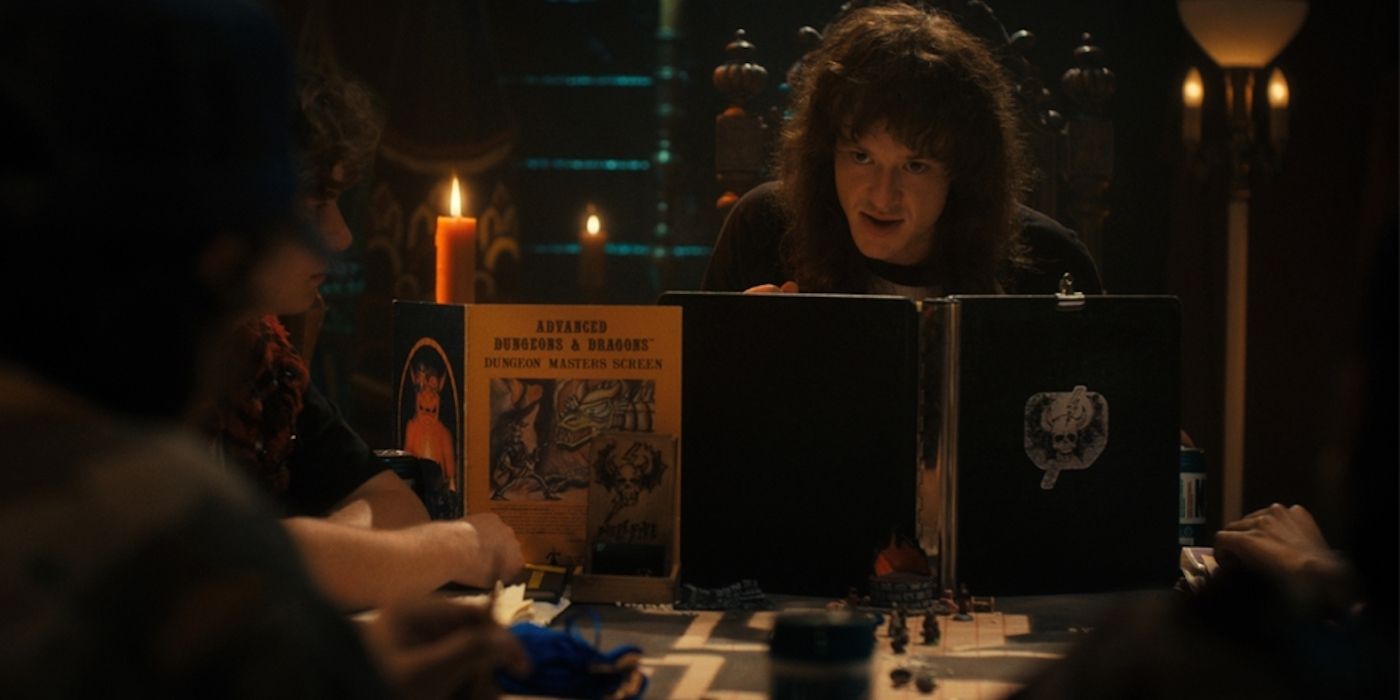The following contains spoilers for Stranger Things Season 4, Volume 1, now available to stream on Netflix.
The fourth season of Stranger Things introduced a new key member of the main group: Eddie Munson, a new friend of Mike, Dustin and Lucas and president of Hawkins High’s Dungeons & Dragons group, the Hellfire Club. Like the kids, Eddie is an outsider in Hawkins, labeled a “freak” for his interests and eccentricities. Unlike the kids, Eddie relishes his status as the town’s resident misfit, antagonizing the normies and laughing in their shocked faces as he does.
This comes back to bite him in Season 4’s first episode, when Hawkins cheerleader Chrissy Cunningham comes to Eddie’s trailer to buy drugs and ends up killed by Vecna, a powerful psychic from the Upside Down and the main villain of Season 4. Eddie goes on the run as the town blames him for Chrissy’s death, eventually coming to believe he’s a genuine Satanist with dark supernatural powers. As ridiculous as it seems, Eddie’s story reflects a real cultural phenomenon: the Satanic Panic, a paranoia over the threat of satanic cults that swept through America in the 1980s and found foes in television, metal music and, of course, roleplaying games.
The roots of the Satanic Panic were sewn throughout the decade preceding it. In 1969, the Manson Family murders shocked the country and preceded a series of highly publicized cults (e.g., SynAnon, The People’s Church) and “ritual” killers (e.g., The Zodiac Killer, The Son of Sam). On top of that, Anton LeVay had become a public figure as High Priest of the Church of Satan and author of The Satanic Bible. On the opposite end of the spectrum, conservative Christians like Jerry Falwell and Robert Grant were organizing the religious Right into a voting block for the first time in American politics to fight against issues like abortion, gay rights and the integration of Christian schools.
The stage was set, but the dam burst in 1980 with the publication of Michelle Remembers, a memoir by Canadian psychiatrist Lawrence Pazder. In it, Pazder claimed that through recovered-memory therapy, he had uncovered repressed memories of abduction and abuse by a Satanic cult in his patient (and later wife) Michelle Smith. Some journalists were quick to point out the inconsistencies in Pazder’s claims and the practice of RMT has since been discredited as pseudoscience. Nevertheless, Michelle Remembers became a bestseller, and Pazder and Smith’s lurid stories of “ritual abuse” were taken as fact by many. The fear of Satanism in America was in full swing — all it needed was the right targets.
One of those targets made itself known a year earlier, when college student James Dallas Egbert III went missing in August 1979. Private investigator William Dear, who was hired to find Egbert, floated the possibility that Egbert’s involvement with his school’s D&D club may have had a hand in his disappearance. The media seized on this angle and roleplaying games became conflated with mental instability and criminal behavior. Egbert was eventually found, but struggled with depression and drug addiction until eventually taking his own life in 1980. The story of his disappearance inspired Rona Jaffe to pen the novel Mazes & Monsters, which was eventually turned into a made-for-TV movie starring a then-unknown Tom Hanks in his first leading role.
D&D was called into question again in 1982, when teenager Irving Pulling II committed suicide. His mother, Patricia Pulling, became convinced that roleplaying games were a factor in Irving’s death and formed the advocacy group Bothered About Dungeons & Dragons (or BADD) to lobby Congress to regulate them. According to BADD, D&D was a recruitment tool for Satanists and used “demonology, witchcraft, voodoo, murder, rape, blasphemy, suicide, assassination, insanity, sex perversion, homosexuality, prostitution, satanic type rituals, gambling, barbarism, cannibalism, sadism, desecration, demon summoning, necromantics, divination and other teachings.” Pulling found some success as a conservative Christian media figure throughout ’80s, but as D&D maintained its popularity, her claims and qualifications were increasingly called into question, if not outright refuted. Pulling eventually quit BADD in 1990.
In hindsight, the Satanic Panic and its fixation on Dungeons & Dragons is a ridiculous example of prejudice and paranoia, but its inclusion in Stranger Things makes sense. After four seasons of being terrorized by extradimensional monsters, the people of Hawkins are convinced their town is cursed; pinning the blame on a misfit kid and his weird hobbies makes the situation more rational. More than that, it continues Stranger Things‘s theme of sympathy for the losers. For all his bluster, Eddie is a genuine friend to the kids of the Hellfire Club and eventually an ally in the fight against Vecna. Like them, he’s ostracized and disparaged by the so-called normal people, and that outsider status in the face of ignorant masses creates an unbreakable bond between the freak and his friends.
Stranger Things Season 4, Volume 1 is available to stream on Netflix. Volume 2 arrives on July 2.
Sources: Gizmodo, Wired, The Believer, Journal of Religion and Popular Culture, Vox


